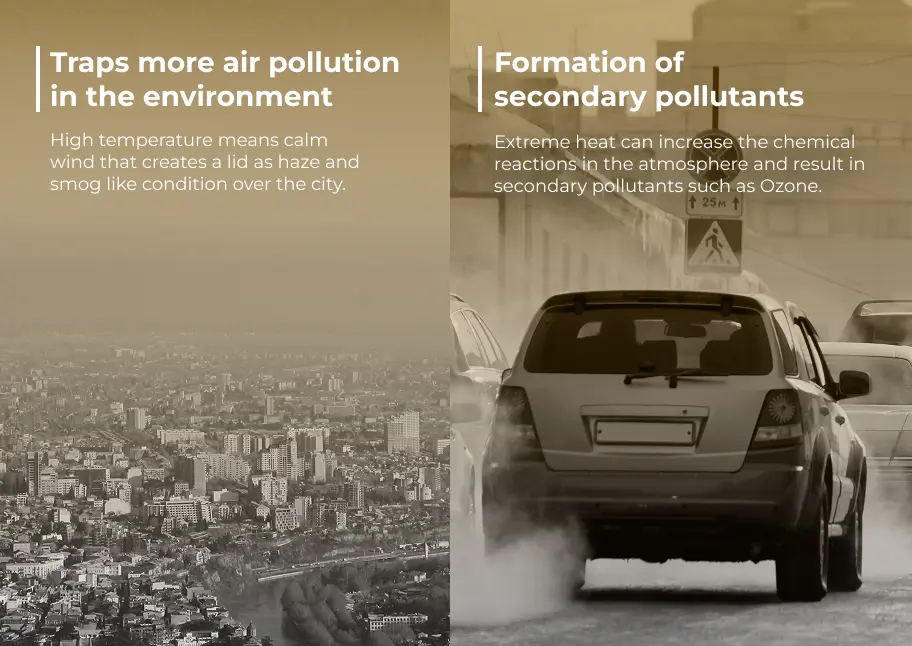Currently, temperatures are increasing in different parts of India, as heat waves are affecting everyone’s day-to-day lives. Besides, the most polluted cities are in India, which are facing high heat levels. But air pollution is a concerning issue, right? A new study published in ‘Environment International’ highlighted the relationship between heat and air pollution, increasing the mortality rates in India. Since this study has analysed around 3.5 million deaths to understand how different environmental factors affected and caused these deaths.
To understand the condition of temperature increase and poor air quality, let us know what the study has revealed. Then you can check how air pollution and high temperatures can trigger extreme health issues.
What is the mechanism behind heat and air pollution resulting in deaths?
For the research study, the researchers collected data from 10 cities in India for different zones. To emphasize, it includes Ahmedabad, Bangalore, Chennai, Delhi, Kolkata, Hyderabad, Kolkata, Mumbai, Pune, Shimla and Varanasi. This helped in knowing the conditions in different cities where air pollution levels are low, and also to understand how heat and air quality can change the dynamics. So, here are the observations:
1. City‐Level Descriptive Statistics
Show how baseline pollution and temperature vary across cities—and how mortality burdens correspond:
| City | Daily Deaths, Mean (SD) | PM2.5 Mean μg/m³ (SD) | Temperature Mean °C (SD) |
| Ahmedabad | 122 (24) | 37.9 (9.7) | 27.0 (4.8) |
| Bangalore | 121 (17) | 33.0 (6.5) | 23.6 (2.1) |
| Chennai | 164 (23) | 33.7 (9.0) | 28.6 (2.4) |
| Delhi | 284 (44) | 113.0 (64.5) | 24.5 (7.2) |
| Hyderabad | 78 (13) | 38.9 (10.4) | 27.1 (3.6) |
| Kolkata | 172 (32) | 55.2 (35.3) | 26.5 (4.3) |
| Mumbai | 251 (28) | 41.7 (18.5) | 26.8 (2.3) |
| Pune | 68 (11) | 45.3 (22.6) | 24.6 (3.2) |
| Shimla | 4 (2) | 28.4 (6.9) | 15.6 (4.7) |
| Varanasi | 22 (6) | 82.1 (35.3) | 25.9 (6.4) |
What does the data highlight?
Researchers have studied how tiny pollution particles (called PM2.5) and high temperatures affect us. Here’s what they found:
- Low Pollution + Heat: Even at 20 µg/m³ of PM2.5 (four times higher than the safe limit), the chance of dying rises by 8.3% on hot days.
- High Pollution + Heat: When PM2.5 hits 100 µg/m³—common in North India—the risk of death shoots up to 63.9%.
- Heat’s Role: On its own, heat is harmful enough, but when paired with poor air quality, deaths from high temperatures jump 1.5 times higher.
These numbers come from looking at over 3.6 million deaths in 10 Indian cities. That’s a lot of people affected—real lives, not just stats.
But how does heat affect air quality, resulting in human deaths?
and heat are both dangerous for human health because our bodies are limited in handling a certain level of heat. But now summers are extreme heat periods where the temperature reaches the 45˚C to 50˚C or more. Besides, air pollution levels in different parts of India are already affecting millions. And do you know the combination of both heat and air pollution can be deadly? So, let us know how heat can impact air quality more and cause more fatalities.

Traps more air pollution in the Air:
High temperature means calm or slow winds, which stabilise the atmospheric conditions. Thus, it creates a lid as haze and smog-like conditions over the city. This is not just ordinary haze because it traps tiny particles such as PM2.5. Due to the heat, these particles build up and make the air more polluted. The collected data highlighted that PM2.5 reached 100µg/m3 in Delhi multiple times.
Formation of secondary pollutants:
Extreme heat can increase the chemical reactions in the atmosphere, such as emissions from vehicles or different sources release PM2.5. This pollutant can react with high heat levels and form dangerous pollutants, for example, Ozone (O2), Nitrogen dioxide (NO2), etc. As a result, it makes the air more toxic to breathe.
How Heat and Pollution Together Cause Deaths?
Together, heat and air pollution react, and it affects each human in that environment thus, the body cannot handle the strain. So, here understand the mechanism behind how heat and air pollution together cause deaths and are more risky:

Double stress on your body:
When you work during extreme heat, your body works harder to stay cool because of the heat. Hence, it causes faster heartbeats and rapid breathing. At the same time, air pollution as PM2.5 particles, can reach deep into your lungs and bloodstreams. Thus, it irritates the tissues and affects your body’s circulatory system. It can make your chest feel like weight-strapped because of the dual burden. As a result, it increases your chances of facing heart attacks, strokes or even respiratory failures. Especially vulnerable people are at high risk of facing death-like conditions.
More inflammation and oxidative stress in your body:
Heat and air pollution cause inflammation, swelling, and irritation inside your body. With this, oxidative stress that can damage your cells is also triggered. Both together inflame the lungs and blood vessels and impact your body’s ability to fight from this. Hence, the data also highlights that an increase in heat and PM2.5 increases the death chances by 63.9% at 100µg/m3 and high heat.
What are the Current Air Quality and Heat Conditions in India?
As of May 19, 2025, North Indian cities are experiencing significant environmental stress. The following table summarizes the current conditions based on real-time data from aqi.in:
| Location | Status | AQI | PM2.5 (µg/m³) | PM10 (µg/m³) | Temp. (°C) | Humi. (%) |
| Ahmedabad | Poor | 111 | 39 | 86 | 35 | 47 |
| Delhi | Unhealthy | 167 | 64 | 210 | 38 | 38 |
| Varanasi | Poor | 74 | 37 | 90 | 34 | 37 |
| Shimla | Poor | 107 | 38 | 104 | 30 | 20 |
| Mumbai | Moderate | 82 | 26 | 84 | 32 | 63 |
| Pune | Moderate | 95 | 32 | 96 | 33 | 47 |
Delhi: PM2.5 at 64 µg/m³ is already past the study’s danger zone. With 33°C (and earlier 2025 peaks above 40°C), it’s a ticking time bomb. Hence, the study says at this level, mortality risk is climbing fast—think 30-40% higher based on the data curve. Moreover, the current heat is persistent in different cities in India. Because the temperature increases every day, resulting in extremely hot days. As a result, with high air pollution levels, as in Delhi and Ahmedabad, this can cause serious health conditions.
Practical Solutions: How to Stay Safe?
You can’t fix the air or cool the planet overnight, but you can protect yourself. So, here are simple, practical steps:
- Know the Risks: Check air quality and weather updates daily. Try sites like aqi.in.
- Be Smart Outdoors:
- Wear an N95 mask to block PM2.5.
- Drink plenty of water to fight the heat.
- Stay inside from 10 AM to 4 PM when it’s hottest.
- Make Home Safer: Use an air purifier and keep windows shut on bad air days.
- Speak Up: Push for cleaner air and climate action—your voice matters.